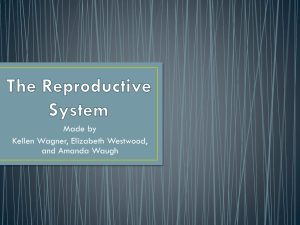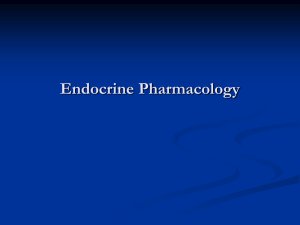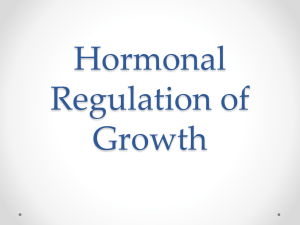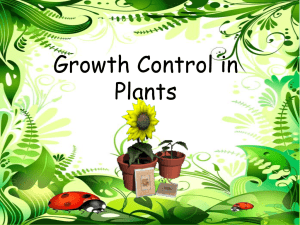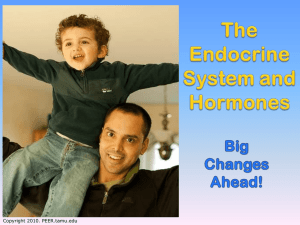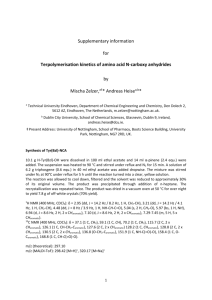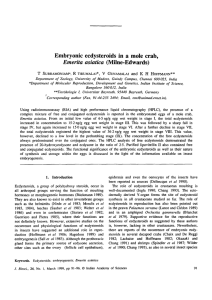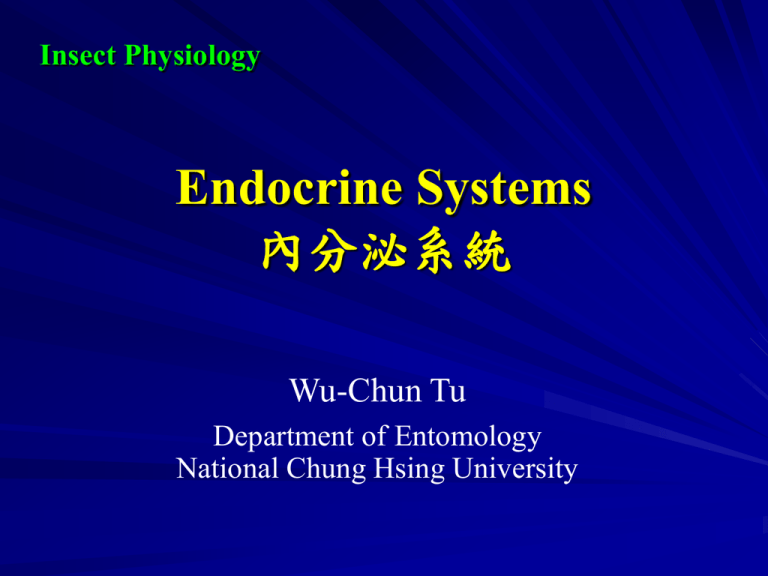
Insect Physiology
Endocrine Systems
內分泌系統
Wu-Chun Tu
Department of Entomology
National Chung Hsing University
Internal Communication
Two systems of internal communication
– Nervous system 神經系統
Rapid
Short-term responses
Direct action between effectors and receptors
– Endocrine system 內分泌系統
Slower
More long-term responses
Blood-borne
CONTENTS
Hormone in Insects
Early Experiments that Set the Stage for
Current Understanding
Types of Hormones in Insects
Prothoracicotropic Hormones
Ecdysteroids
The Juvenile Hormones
Other Neuropeptides Found in Insects
Vertebrate-Type Hormones in Insects
What Are Hormones?
Classical definition
– Hormones are chemical substances produced
by specialized tissues (glands) and secreted
into blood, in which they are carried to
target organs.
Modern definition
– Hormones are chemical substances that
carry information between two or more cells
at micromolar concentration or less.
Animal and plant cells
– Have cell junctions that directly connect the
cytoplasm of adjacent cells
Plasma membranes
Gap junctions
between animal cells
Plasmodesmata
between plant cells
Cell junctions. Both animals and plants have cell junctions that allow molecules
to pass readily between adjacent cells without crossing plasma membranes.
In local signaling, animal cells
– May communicate via direct contact
Cell-cell recognition. Two cells in an animal may communicate by interaction
between molecules protruding from their surfaces.
In other cases, animal cells
– Communicate using local regulators
Local signaling
Target cell
Electrical signal
along nerve cell
triggers release of
neurotransmitter
Neurotransmitter
diffuses across
synapse
Secretory
vesicle
Local regulator
diffuses through
extracellular fluid
(a) Paracrine signaling. A secreting cell acts
on nearby target cells by discharging
molecules of a local regulator (a growth
factor, for example) into the extracellular
fluid.
Target cell
is stimulated
(b) Synaptic signaling. A nerve cell
releases neurotransmitter molecules
into a synapse, stimulating the
target cell.
In long-distance signaling
– Both plants and animals use hormones
Long-distance signaling
Blood
vessel
Endocrine cell
Hormone travels
in bloodstream
to target cells
Target
cell
(c) Hormonal signaling. Specialized
endocrine cells secrete hormones
into body fluids, often the blood.
Hormones may reach virtually all
body cells.
Examples of Neurotransmitter Release
神經傳導物質
神經賀爾蒙
賀爾蒙
神經調節物質
Neurohemal organ
Receptor
Hormone in Insects
Insect hormones affect a wide variety of
physiological processes including
–
–
–
–
–
–
–
–
–
–
–
Embryogenesis 胚胎發育
postembryonic development 後胚期發育
Behavior 行為
water balance 水分平衡
Metabolism 代謝
Caste determination 位階決定作用
Polymorphism 多型性
Mating 交配
Reproduction 生殖
Diapause 滯育
Others
Endocrine Organs in Insects
Conventional endocrine glands 內分泌腺
–
–
–
–
(hormone synthesis and secretion)
Prothoracic glands (PGs) 前胸腺
Corpora allata (CA) 咽喉側腺
Corpora cardiaca (CC) 心臟內泌體
Ovaries and testes
Neurosecretory cells (NSC) 神經內泌細胞
– Produce small neuropeptides – neurohormones
– They can be found in brain (major source) and all
the ganglia.
Endocrine Organs in Insects
Prothoracic glands (PGs)
– The source of ecdysteroids 脫皮固醇
Corpora allata (CA)
– The source of juvenile hormones 青春賀爾蒙
Corpora cardiaca (CC)
– The source of neuropeptide hormones 神經肽
Ovaries and testes 卵巢與精巢
– Ovaries: ecdysteroid 脫皮固醇
– Testes: androgen hormone of European firefly,
Lampyris noctinca 雄性素
Endocrine Organs in Insects
The Innervation of the Corpora Allata and
Corpus Cardiacum in the Locust
Neurosecretory Cells in
Insect Nervous System
Fig. A general scheme for pathways of neuroendocrine
regulation in insects.
Early Experiments
Bataillon (1894) – the first evidence for the
existence of hormones in insects.
– ligature of silkworm larvae
Kopeć (1917) – confirmation of the presence of
hormones in insects.
– ligature of last instar larvae of gypsy moth (next slide)
– removal of the brain of gypsy moth larvae
Wigglesworth (1930s) – demonstrating that
neurosecretory cells are indeed the source of the
brain’s endocrine effect.
– decapitation of the blood sucking bug (next slide)
Types of Hormones in Insects
Steroid hormone
– ecdysteroids
Sesquiterpenes
– juvenile hormones
Peptide hormones
– prothoracicotropic hormone (PTTH)
– many others
Biogenic amines
– octopamine
– serotonin
Factors that Affect
the Activity of Hormones
Circulating titer of hormone
Modes of Actions
Non-polar hormones (next slide)
– Hormones are able to enter the cell and
bind to cytosolic and nuclear receptors.
– e.g. juvenile hormones, ecdysteroids
Polar hormones (next slide)
– Hormones can not pass through the cell
membrane.
– Via the synthesis of second messenger
molecules that carry the message inside
the cell.
– e.g. peptide hormones
G-protein-linked receptors
Relay protein
Receptor tyrosine kinases
Signal-binding sitea
Signal
molecule
Signal
molecule
Helix in the
Membrane
Tyrosines
Tyr
Tyr
Tyr
Tyr
Tyr
Tyr
Tyr
Tyr
Tyr
Tyr
Tyr
Tyr
Tyr
Tyr
Tyr
Tyr
Tyr
Tyr
Receptor tyrosine
kinase proteins
(inactive monomers)
CYTOPLASM
Dimer
Activated
relay proteins
Tyr
Tyr
P Tyr
Tyr P
P Tyr
Tyr P
Tyr
Tyr
P Tyr
Tyr P
P Tyr
Tyr P
Tyr
Tyr
P Tyr
Tyr P
P Tyr
Tyr P
6
ATP
Activated tyrosinekinase regions
(unphosphorylated
dimer)
6 ADP
Fully activated receptor
tyrosine-kinase
(phosphorylated
dimer)
Inactive
relay proteins
Cellular
response 1
Cellular
response 2
Many G-proteins
– Trigger the formation of cAMP, which then
acts as a second messenger in cellular
pathways
First messenger
(signal molecule
such as epinephrine)
Adenylyl
cyclase
G protein
G-protein-linked
receptor
GTP
ATP
cAMP
Protein
kinase A
Cellular responses
Calcium is an important second
messenger
– Because cells are able to regulate its
concentration in the cytosol
EXTRACELLULAR
FLUID
ATP
Plasma
membrane
Ca2+
pump
Mitochondrion
Nucleus
CYTOSOL
Ca2+
pump
ATP
Key
Ca2+
pump
Endoplasmic
reticulum (ER)
High [Ca2+]
Low [Ca2+]
1 A signal molecule binds
2Phospholipase C cleaves a
to a receptor, leading to
activation of phospholipase C.
EXTRACELLULAR
FLUID
3 DAG functions as
a second messenger
in other pathways.
plasma membrane phospholipid
called PIP2 into DAG and IP3.
Signal molecule
(first messenger)
G protein
DAG
GTP
G-protein-linked
receptor
PIP2
Phospholipase C
IP3
(second messenger)
IP3-gated
calcium channel
Endoplasmic
reticulum (ER)
Various
proteins
activated
Ca2+
Cellular
response
Ca2+
(second
messenger)
4 IP3 quickly diffuses through
the cytosol and binds to an IP3–
gated calcium channel in the ER
membrane, causing it to open.
5Calcium ions flow out of
the ER (down their concentration gradient), raising
the Ca2+ level in the cytosol.
6The calcium ions
activate the next
protein in one or more
signaling pathways.
A phosphorylation cascade
Signal molecule
Receptor
Activated relay
molecule
Inactive
protein kinase
1
1 A relay molecule
activates protein kinase 1.
2 Active protein kinase 1
transfers a phosphate from ATP
to an inactive molecule of
protein kinase 2, thus activating
this second kinase.
Active
protein
kinase
1
Inactive
protein kinase
2
ATP
ADP
Pi
PP
3 Active protein kinase 2
then catalyzes the phosphorylation (and activation) of
protein kinase 3.
P
Active
protein
kinase
2
Inactive
ATP
protein kinase
ADP
3
5 Enzymes called protein
phosphatases (PP)
PP
catalyze the removal of
Pi
the phosphate groups
Inactive
from the proteins,
protein
making them inactive
and available for reuse.
Active
protein
kinase
3
P
4 Finally, active protein
kinase 3 phosphorylates a
protein (pink) that brings
about the cell’s response to
the signal.
ATP
ADP
Pi
PP
P
Active
protein
Cellular
response
Nitric Oxide as A Second Messenger
Central nervous system
Malpighian tubules
Compound eye develop
Activation of cGMP-dependent enzymes
Permeability of membrane channels
Prothoracicotropic Hormone (PTTH)
The first insect hormone to be discovered.
PTTH acts on the prothoracic glands (PTGs) to
regulate the synthesis of ecdysteroids.
Williams (late 1940s - early 1950s) demonstrated the
relationship of PTTH and PGs.
– Implanted both the PGs and a brain into a diapausing
pupa
– Parabiosis (next slide)
Bollenbacher (1979) developed a more direct assay
for PTTH.
– Using the criterion of ecdysone production by a pair of
PGs in vitro. (next slide)
The Amino Acid Structure of PTTH
224-amino-acid precursor ; 109-amino-acid functional
In Bombyx mori
Groups of PTTH
Big PTTH : 14-29 kDa
True PTTH
Small PTTH : 3-7 kDa
Bombyxin :
receptor in some ovaries of lepidopterans
— involved in ovarian development
— utilization of carbohydrate during egg maturation
Sources of PTTH
The main sites of production are the
neurosecretory cells (NSCs) in the brain.
(next slide)
PTTH activity has also been identified in
the subesophageal ganglion and the
ganglia of the ventral nerve cord.
Control of PTTH Release and Its
Mode of Action
Control of PTTH release
– environmental stimuli such as
photoperiod, temperature
– nervous stimuli such as stretch
receptors
Mode of action
– Via a second messenger, cAMP
Ecdysteroids
Hachlow (1931) showed an organ in the thorax was
also necessary for molting and metamorphosis;
Fukuda (1940) demonstrated that this particular
organ was the prothoracic gland.
Ecdysone was the first insect hormone to be
structurally identified.
Butenandt and Karlson purified 25 mg of the
hormone starting with approximately 500 kg of B.
mori pupae.
Two major forms of ecdysteroids
• α-ecdysone: ecdysone
• β -ecdysone: 20-hydroxyecdysone
The Calliphora Bioassay Developed by
Fraenkel (1934)
Precursor and Synthesis of Ecdysteroids
The precursors for ecdysteroid synthesis are sterols, such
as cholesterols. (campesterol; sitosterol; stigmasterol)
Insects cannot synthesize cholesterols and require
cholesterol in their diets.
The primary site of ecdysteroid synthesis is the prothoracic
gland; the major product is ecdysone.
Ecdysone (inactive form) is converted to 20hydroxyecdysone (active form) by target tissues.
Some Common Ecdysteroids
embryos
28
Honeybee
Hemipterans
Dipterans
embryos
Synthesis of the Various Ecdysteroids from
Cholesterol in Some Lepidopterans
Carrier proteins
Prothoracic Glands (PG)
The ring gland of higher dipterans.
環 腺
Prothoracic Glands (PG)
A. Blattaria
B. Hemiptera
C. Lepidoptera
D. Hymemoptera
Prothoracic gland degeneration
PTG exposure to ecdysteroids in the absence of JH
Ecdysteroids acting alone trigger apoptosis by the PTG cells
Adult pterygote insects
Apterygote insects retain active PTG
Other Sources of Ecdysteroids
Ovaries
– Incorporated into the eggs for later use during
embryogenesis (follicle cells)
– Stimulate fat body to activate the synthesis of
yolk proteins.
Testes
– Sheaths cells produce
Epidermal cells
– During certain developmental stages
Neurohormones : Ovarian ecdysiotropic hormones
Testes ecdysiotropin
Mode of Action of Ecdysteroids
Chromosome Puffs in Drosophila
Polytene Chromosomes
Early puffs : hormone directly
Late puffs
Puffing patterns are correlated
with the development stage
Hormone receptor complex
receptor
ultraspiracle gene
EcR
Isoforms
in different
cells
Morphogenesis
of salivary gland
Fig. A model originally proposed by Ashburner (1974) for the
action of ecdysteroids in the Drosophila salivary gland.
Juvenile Hormones (JHs)
First described by Wigglesworth as an
“inhibitory hormone” that prevented the
metamorphosis of the Rhodnius prolixus.
JH is synthesized in and released from the
corpus allatum (CA)
JHs belong to sesquiterpenes
JHs have multiple effects during the life of an
insect, especially involvement in
–
–
–
–
Metamorphosis
Diapause
Reproduction
Metabolism
Endocrine Organs in Insects
The Location and Structure of the
Corpus Allatum
A.
B.
C.
A mosquito
A cockroach
A hemipteran
Six Major Members of the JHs
19
18
19
17
17
16; dipterans, ticks
2 epoxide group
Examples of Hydroxy Juvenile Hormones
(produced by the CA of locusts and cockroaches)
This hydroxylation may
result in molecules with
greater biological activity,
just as 20-hydroxyecdysone
is more active than ecdysone
Initial Steps in the Synthesis of
Common Juvenile Hormones
Final Steps in the Synthesis of JH III
Examples of Some JH Analogs
Control of JH Production
Hemolymph JH titers are regulated by both
biosynthesis and degradation.
JH synthesis is rigidly controlled along several
avenues
– environmental stimuli – e.g. photoperiod
– endogenous factors – e.g. mating, nutritional state
Neurohormones that affect CA activity
– allatotropins – stimulate JH production
– allatostatins – inhibit JH synthesis by the CA
– allatoinhibin – inhibits the Manduca CA nonreversibly
The Overall Regulation of
the Corpus Allatum
(feedback regulation)
JH Transportation in the Hemolymph
Because of its lipophilic nature, JH must be
bound to other molecules in order to move
through the aqueous hemolymph.
Perhaps more importantly, binding can also
protect the hormone from degradation by
nonspecific tissue-bound esterases.
Juvenile hormone binding proteins (JHBPs)
– Low molecular weight binding proteins with single
JH binding site. 32kDa
– High molecular weight binding proteins (i.e.
lipophorins) with multiple JH binding sites.
250 and 80 kDa apoprotein
– A 566 kDa hexameric protein with six JH binding
sites
Degradation of Juvenile Hormones
Fig. Hormone titers during the last two larval instars of Manduca sexta.
Mode of Action of JH
The major role of JH in insects is to
modify the action of ecdysteroids and
prevent the switch in the commitment of
epidermal cells.
JH influences the stage-specific
expression of the genome that is
initiated by ecdysteroids.
USP is a possible nuclear receptor of JH.
Fig. A model originally proposed by Ashburner (1974) for the
action of ecdysteroids in the Drosophila salivary gland.
Other Neuropeptides Found in Insects
Adipokinetic hormones (AKH)
– Mobilization of lipids from fat body to
hemolymph in locust
– Increase of blood hemolymph trehalose
levels in several insects
– Stimulation of heart beat frequency in
cockroaches
– Inhibition of protein synthesis in locust and
cricket
– Inhibition of fatty acid and RNA synthesis in
locust fat body
– Source: CC
Other Neuropeptides Found in Insects
Diuretic hormone (DH)
– Water balance
– Source: abdominal ganglia, brain, CC
Proctolin
– Muscular contraction
– Source: ganglia of the CNS
Pheromone-biosynthesis-activating
neuropeptides (PBAN)
– Regulate sex pheromone biosynthesis
– Source: ganglia of the CNS
Eclosion hormone (EH)
– Ecdysis and eclosion
– Source: CC
Other Neuropeptides Found in Insects
Crustacean cardioactive peptide (CCAP)
– Stimulate heartbeat after adult emergence,
facilitate wing inflation, increase hemolymph
circulation
– Source: abdominal ganglia
Bursicon
– Sclerotization of the cuticle (hardening and
tanning)
– Source: most ganglia of the CNS
Other Neuropeptides Found in
Insects
Ecdysis-triggering hormone
– Stimulate muscle contraction and heartbeat
– Activate eclosion hormone release
– Source: epitracheal glands
Vertebrate-type Hormone in Insects
Insulin
Bombyxin – homology with the A chain of
vertebrate insulin
Melanization-reddish coloration hormone in B.
mori – homology with insulin-like growth
hormone
Sulfakinins – similar to gastrin and
cholecystokinin (CCK)
Somatostatin-like hormone
control other hormone release
Adipokinetic hormone – similar to glucagon
FMRFamid-related peptides
Melatonin
In Conclusion
An Experiment Performed by Kopeć
Critical period
Wigglesworth’s Decapitation
Experiments Using Rhodnius Larvae
Critical period
The Mode of Action of
Steroid Hormones
Transcription factor
Signal Transduction via
Second Messenger
DAG: diacylglycerol
IP3: triphosphoinositol
PIP2: phosphatidylinositol 4,5-diphosphate
PLC: phospholipase C
An Experiment by Williams (1952)
An Assay for PTTH Developed by
Bollenbacher et al. (1979)
Endocrine Organs in Insects

